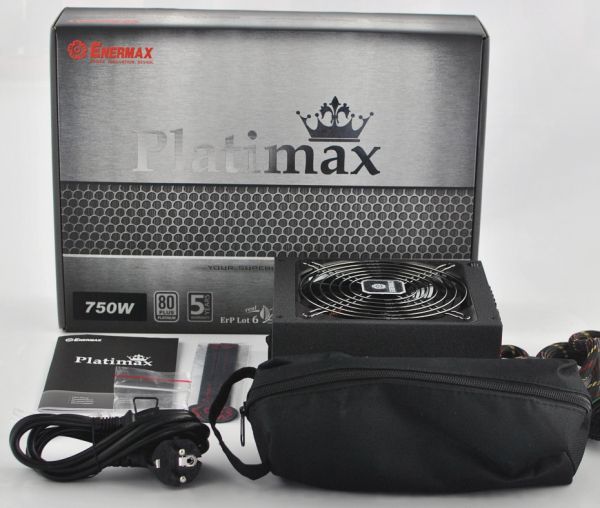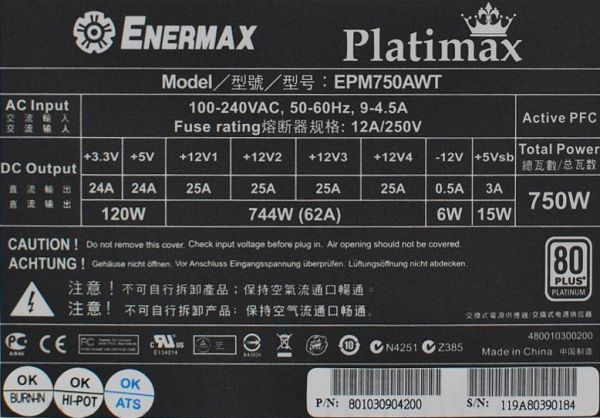Enermax Platimax 750W - 80 Plus Platinum Arrives
by Martin Kaffei on February 10, 2012 6:00 PM EST- Posted in
- Cases/Cooling/PSUs
- PSUs
- 80Plus
- 750W
- Enermax
- 80Plus Platinum
Package Contents, Power Rating, and Fan
The contents in the package are very generous. Besides the so-called "CordGuard" that secures the power cord, users get some Enermax cable ties, an Enermax sticker, a user manual, and the modular cables in a separate bag. Features of the product include the 80 Plus Platinum certificate, a 5 year warranty, the improved resonant converter, and other technical refinements; we'll cover those in more detail later. There is also a "HeatGuard", which is nothing more than a temperature monitor that will continue to cool the PSU after you shut off the PC/PSU (if necessary).
According to the label the PSU has four +12V outputs rated at 25A each, which together can provide almost the entire power output (744W). Both +3.3V and +5V are specified at 24A. Those outputs can provide up to 120W, which is slightly lower than the values from most power supplies in this performance class but typically more than sufficient for modern PCs. The +5VSB at 3A is also relatively strong.
Enermax relies on its own high-quality Twister fan for cooling, with the model number EA142512W-OAB. This one has seven transparent fan blades and is based on Enermax's "Twister Bearing". The fan is rated at just 0.15A current, which is rather moderate. The fan runs at low speeds ranging from 300 to 1000RPM. Well, at least that applies to the fan in Platimax models below 1000W. Thanks to some patents, the fan has a 13.9cm diameter, but it's basically a 140mm fan.













47 Comments
View All Comments
airmantharp - Friday, February 10, 2012 - link
Did you mean results?Only posted for the humor involved :).
JarredWalton - Saturday, February 11, 2012 - link
There are times when I miss our old CMS system where misspelled words were immediately underlined. Sorry for the error. ;-)Termie - Friday, February 10, 2012 - link
Did I miss it, or did you not actually list the price of the power supply in this article? I would think that would be a critical element of the review. You repeat several times that this is a very expensive power supply, but without a price stated, I don't think your readers will be able to draw any conclusions from this.I know Newegg currently has a paid add running at the top of this article showing its price for this product, but that is not the same thing as stating the price in your article.
JarredWalton - Saturday, February 11, 2012 - link
We linked to the lowest price we could find in the second to last paragraph, but you're right -- nowhere did we actually list the price. I have added that information to the same paragraph now. Thanks!DanNeely - Friday, February 10, 2012 - link
"Does anyone actually detach their CPU/mainboard cables?"2x12V cables is still a relatively high end mobo feature. Being able to get rid of one of these cables would be beneficial for many people.
Also putting jacks on the chassis for cables (GPU3, Peripheral5) only provided in high end models is rather lame in a high end model. A second plug board that leaves the two spaces unsoldered, and without cutouts in the housing shouldn't be prohibitively high as additional engineering work.
Amoro - Friday, February 10, 2012 - link
It looks like it actually failed the requirements for platinum specification at 20% load, achieving only 88.79% instead of the 90% required.Iketh - Friday, February 10, 2012 - link
I was disappointed I didn't learn what a Platinum Certification is in this article. That's the only reason I clicked the article was to get a rundown on the spec itself.Google to the rescue...
Galcobar - Friday, February 10, 2012 - link
Indeed, given the whole article is pitched as being about the arrival of a PSU able to meet the Platinum specifications, I was expecting to be told what the Platinum spec actually meant.As a result, I'm left with another question: did this PSU actually pass the Platinum specs, and at what temperature? Ecos Consulting (the company behind 80 Plus) tests at 23C, actually below the engineering standard room temperature of 25C; lower temperatures make for greater efficiency and slower fan speeds.
JarredWalton - Saturday, February 11, 2012 - link
Thanks for the comments -- I've added a bit of information to the text now.gwolfman - Monday, February 20, 2012 - link
But does this (the certification) have to apply to 120VAC/60Hz? If I remember correctly, 240VAC/50Hz is more efficient to convert to 12VDC, which will take this PSU to new heights.